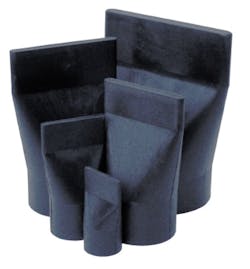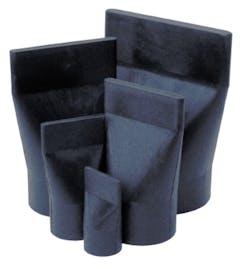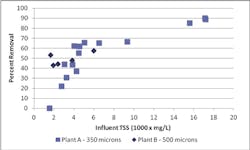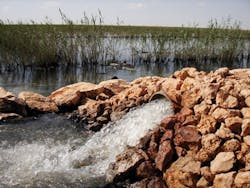Diagnostic Program Helps Maximize Well Field Performance
Leggette, Brashears & Graham (LBG) developed the Optimize Well Life and Performance (OWL) Program to optimize the performance and life of drinking water wells. The program consists of routine testing which includes review of existing well performance data combined with short-term testing to identify when and how wells should be treated to optimize performance.
By Ken Taylor
A poorly performing well deprives a provider of water and may give the appearance there is a need to install more wells. Given the difficulty and high cost of drilling additional wells or purchasing water from other sources, proper well maintenance is critical. Wells in optimal operating condition could make the difference in being able to meet peak summer demand periods and postpone the need to develop new sources. That’s why it pays to identify wells with declining performance early so that they can be brought back to top performance before it’s too late.
To identify and address declining well yields, Leggette, Brashears & Graham (LBG) developed the Optimize Well Life and Performance (OWL) Program. This low cost program was designed to determine the timing of well rehabilitation and evaluate whether pump maintenance or replacement is practical. The key benefit to the well owner and/or operator is to be able to make redevelopment or pump repair decisions based on actual performance data and trend analyses, not on a fixed interval or in response to low-water alarms. Furthermore, the program identifies problems more efficiently than is possible by scanning random data in a table.
This type of diagnostic program can save the owner money by eliminating unnecessary rehabilitation on wells that are not truly in need, and can result in much better pumping capabilities during peak demand periods by keeping the wells in top condition. It provides well owners and/or operators with an evaluation of historical well performance for each production well compared to the permit limit of the system; annual tracking of well performance data for each well and recommendations for well rehabilitation and/or pump maintenance.
Additionally, the program provides recommended redevelopment techniques and optionally, oversight during the redevelopment effort to ensure the best techniques are being used. The owner/ and/or operator is also provided with an annual report that presents historical data in tables and graphs, with an analysis of well performance trends.
The program is easy to implement and can be customized to each individual operator’s needs, depending on how much monitoring an operator wants to undertake directly. The program also provides examples of the steps owners and/or operators can take to optimize their well field efficiency.
Well Diagnostics are Key
As with any diagnostic program of this type, the first step in implementing an OWL or similar type of program is the review of any available historical data the owner/operator has for each production well. In general the data reviewed include the geologic log and well construction information, the production well’s original well completion aquifer test, historical water quality data, all existing well rehabilitation reports and the production pump curves.
Data from the original well completion test, when the well was first installed and presumably operating most efficiently (assuming that the installation was done properly) and/or after a well rehabilitation program are used to document the well’s optimal performance or baseline condition. Well performance is monitored using specific capacity (the yield of the well per foot of drawdown).
Once a well’s baseline condition is established, it is important to have a thorough understanding of the well’s current pumping rates and specific capacities, and the specific capacity trends for each production well. Typically this information is obtained by reviewing current and historical well operational data (well yield, static water levels and pumping levels). If the operator does not have this data available, or if the data is incomplete , a recovery test program would be implemented to collect the missing data. For these tests, each well would be operated for at least eight hours and then pumping rates and pumping water levels would be collected prior to the well being shut down.
After well shutdown, water levels would be measured over a period of 30 minutes and a specific capacity would be determined based on the water level at the end of this period. Water temperature and pump discharge pressure would also be noted prior to well shutdown, as would all other wells operating in the well field during testing.
The performance of each production well would then be evaluated by comparing the current specific capacity trends to the results from the original well completion pumping test and/or after a well redevelopment program. Charts and tables would be generated to aid in determining which wells are experiencing issues and in making recommendations as to what measures should be taken to restore them to optimum performance.
The OWL program is best explained in the related graph which shows the specific capacity of a production well over a 40-year period.
As shown in the graph, redevelopment of this well prior to 1995 (Period A) would be unwarranted and an unnecessary operational cost. By implementing a diagnostic program, declining well performance (Period B) would be identified before redevelopment efforts were too late to restore the well performance (Period C).
In addition to determining the timing of well rehabilitation the graph also allows rehabilitation professionals to narrow down potential causes of the declining well performance. For example: a gradual or steady decrease in specific capacity over a five or six year period may be indicative of a gradual plugging of the well screen and gravel pack by fine grain material in the formation. By contrast, a sharp drop in performance after a long-term, consistent pumping yield (as seen from 1995 to 1997 on the graph above) suggests the presence of nuisance bacteria. Since the biofouling process is very difficult to reverse once it has started, it is important to address it through rehabilitation before it significantly affects the performance of the well.
Each According to Their Needs
Once potential causes of a well’s declining performance have been identified using the graphic data, it is important to choose rehabilitation methods that are most appropriate for the conditions affecting the well and not the most commonly used. For example, in a study conducted under the auspices of the American Waterworks Association (AWWA) [for a copy of the study go to www.awwa.org.], LBG found that productivity resulting from rehabilitation for a production well with a severe biofouling problem increased from three months to two years when chemicals specifically designed to address biofouling were used in the rehabilitation process. The objective of the AWWA study was to test and compare various techniques for well rehabilitation.
A Case in Point: The Aquarion Project
In response to reduced pumping rates at the end of the peak pumping season in 2010, LBG initiated the OWL program for the Aquarion Water Company’s Lower Fairfield County, Connecticut Well Fields. Based on the results of the data review and a recovery test program, it was recommended that two of the wells be rehabilitated and three wells video-inspected to aid in the determination of the cause of each well’s performance loss.
During the spring of 2011 Aquarion rehabilitated the two production wells using mechanical surging and chemical treatments, including the application of inhibited muriatic acid, NW-220 (a nonphosphate liquid polymer dispersant) and chemicals designed specifically to address biofouling issues. The use of these treatments was specified because of the amount of incrustation, debris, and biomass on the well screen that had been documented by the video inspections. The inhibited acid was used during the rehabilitation because of the age of the well screens (dating back as far as the1960s).
Post rehabilitation aquifer tests have shown a 39 percent increase in specific capacity for the first well and a dramatic 230 percent increase in specific capacity for the second. Based on a video inspection documenting a heavy biomass, a third well is slated for rehabilitation in the fall of 2011. The results of the rehabilitation efforts have provided Aquarion with more flexibility in meeting peak summer demands in 2011 and will enable the company to operate its wells in a more cost-effective manner.
WW
About the Author: Kenneth Taylor is a Senior Associate in the Shelton, CT, office of Leggette, Brashears & Graham Inc., a professional groundwater and environmental engineering services firm.
More WaterWorld Current Issue Articles
More WaterWorld Archives Issue Articles



